

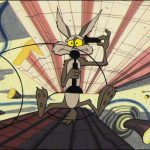

Today, we transition from the 50’s into the early half of the 1960’s in theatrical cartoons. By this time, Warner Brothers was pretty much king of the short subjects screen, though its golden days were numbered, and Termite Terrace would soon cease to be. Resultingly, the Looney/Merrie crew provide the lion’s share of the action today. One lion, however, growls again, as MGM contributes one entry under the helm of Gene Deitch, who also has one more Terrytoon to contribute from an earlier season. Pencil and paintbrush tricks, and on-screen consciousness, again abound, as described below.
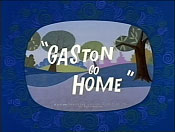 Gaston, Go Home (Terrytoons/Fox, Gaston Le Crayon, May 1958 – Connie Rasinski, dir.) – After establishing Gaston’s magical abilities to paint functional objects into existence from mere pigment in “Gaston Is Here”, it is strange that only one follow-up episode would exhibit this talent again. Our story opens with a long panning shot, beginning with the tall spires of the New York skyline and the familiar Statue of Liberty, across town to the tenement section, and past it to the far reaches of the island, and the city dump. It is here we find Gaston, brooding over his latest canvas, a replication of a Tolouse Lautrec-style cabaret poster of French dancing girls. Gaston realizes there is nothing like Paris night life, and is homesick. But, turning his trouser pockets inside out to reveal them empty, he can only face the stark truth, “Gaston, you are a bum.” However, the sound of a ship’s whistle from the nearby docks provides a ray of hope. The steamship Ile De Paris prepares for a voyage. Brazen Gaston determines to become a passenger, money or no money. He trots right on past a seaman at the gangplank, bidding him a happy “Vive la France” as he passes. A moment later, he departs with equal haste, as the captain carries him down the plank, and throws him back onto the pier. “Vive la America”, is all that Gaston can moan as he is thrown. However, Gaston vows, “Where there is a will, there is a stowaway.” He approaches the ship from another point of the wharf, not quite extending to the ship’s side, then pulls out his trusty paintbrush. With a few quick strokes, Gaston draws an extension to the wharf, allowing him to reach the ship. He then paints a porthole upon the ship’s side, and opens it to enter. He is doused with a gooey faceful of machine oil, and quickly closes the porthole. “Wrong compartment”, he concludes. Gaston thus paints himself a ladder, and sets it upon the painted wharf extension. He climbs up several stories, then paints another porthole upon the ship. As he attempts to climb in, he is stopped cold by the sound of a loud slap. Gaston emerges, with the red handprint of a woman’s hand prominently visible upon his cheek. In a much more suggestive and appreciative tone, Gaston repeats to the audience, “Wrong compartment!” Gaston’s brush goes to work again, this time overdoing it, extending the ladder upwards until it is about ten feet taller than the ship itself. He draws another porthole, only this time, it is hanging in mid-air. Gaston climbs through the hole, but finds himself dangling from the painted circle, amazed at how tall this stateroom must be. His feet funally make contact with something – the nose of the captain on deck below. Gaston is hurled overboard, but briefly rises upon the wave caused by his splash, to exchange another genial “Vive La France” with the captain.
Gaston, Go Home (Terrytoons/Fox, Gaston Le Crayon, May 1958 – Connie Rasinski, dir.) – After establishing Gaston’s magical abilities to paint functional objects into existence from mere pigment in “Gaston Is Here”, it is strange that only one follow-up episode would exhibit this talent again. Our story opens with a long panning shot, beginning with the tall spires of the New York skyline and the familiar Statue of Liberty, across town to the tenement section, and past it to the far reaches of the island, and the city dump. It is here we find Gaston, brooding over his latest canvas, a replication of a Tolouse Lautrec-style cabaret poster of French dancing girls. Gaston realizes there is nothing like Paris night life, and is homesick. But, turning his trouser pockets inside out to reveal them empty, he can only face the stark truth, “Gaston, you are a bum.” However, the sound of a ship’s whistle from the nearby docks provides a ray of hope. The steamship Ile De Paris prepares for a voyage. Brazen Gaston determines to become a passenger, money or no money. He trots right on past a seaman at the gangplank, bidding him a happy “Vive la France” as he passes. A moment later, he departs with equal haste, as the captain carries him down the plank, and throws him back onto the pier. “Vive la America”, is all that Gaston can moan as he is thrown. However, Gaston vows, “Where there is a will, there is a stowaway.” He approaches the ship from another point of the wharf, not quite extending to the ship’s side, then pulls out his trusty paintbrush. With a few quick strokes, Gaston draws an extension to the wharf, allowing him to reach the ship. He then paints a porthole upon the ship’s side, and opens it to enter. He is doused with a gooey faceful of machine oil, and quickly closes the porthole. “Wrong compartment”, he concludes. Gaston thus paints himself a ladder, and sets it upon the painted wharf extension. He climbs up several stories, then paints another porthole upon the ship. As he attempts to climb in, he is stopped cold by the sound of a loud slap. Gaston emerges, with the red handprint of a woman’s hand prominently visible upon his cheek. In a much more suggestive and appreciative tone, Gaston repeats to the audience, “Wrong compartment!” Gaston’s brush goes to work again, this time overdoing it, extending the ladder upwards until it is about ten feet taller than the ship itself. He draws another porthole, only this time, it is hanging in mid-air. Gaston climbs through the hole, but finds himself dangling from the painted circle, amazed at how tall this stateroom must be. His feet funally make contact with something – the nose of the captain on deck below. Gaston is hurled overboard, but briefly rises upon the wave caused by his splash, to exchange another genial “Vive La France” with the captain.
Gaston finds himself under the ship. Well, when in doubt, use what’s worked before. He draws a porthole upon the base of the ship’s hull, underwater. When he opens it, the Captain rises into the air upon a jet of water from amidship. Gaston also enters upon the stream, but leaps out, standing to one side inside the hull. “Have no fear, Gaston is here.” A few more paint strokes, and he produces a cork to plug the hole. Unfortunately, shutting off the water flow sends the captain falling face first. His head pops the cork through the porthole, and his face becomes the new plug, as he rests helplessly upside down in the hole, the remaining water from the previous leak landing inside the captain’s outfit like an inverted umbrella.
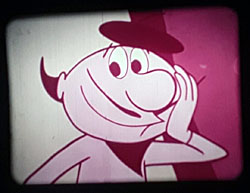 Somehow, the captain manages to extricate himself. Sensing his approach, Gaston draws a fake door across a gap in the railing where the gangplank had previously stood, then ducks behind it. When the captain arrives, Gaston’s hand emerges to point at the door, “He goes that-a-way.” The captain charges, pushing the door open, racing out into mid-air. Shouting unintelligible French, the captain does a 180 degree turn, racing back for the ship – but Gaston slams the door in his face. The captain slides down, but is saved from a swim, as he finds himself dangling by his nose upon the edge of an open porthole (for once, a real one). Gaston meanwhile settles down for a nap in a deck chair. The captain’s head emerges from a cabin window above him. His hand also emerges with a champagne bottle, ready to clobber Gaston, But the Captain looks at the audience, and shakes his head – not good enough. He disappears back into the cabin, returning with a loaded pistol, and takes aim. But again, he shakes his head – still not good enough. Gaston begins to smell smoke, which he mistakes for French cooking. But it is the fumes of the fuse of a large cannon, carried upon the captain’s back and aiming out the cabin window. BOOM! All that seems to be left of the deck chair is a large swath of char marks. The happy, snickering captain heads for the ship’s restaurant, eager to celebrate with a hearty meal. Instead, he finds Gaston, under the lid of his serving tray, obviously lured to the kitchen by the smoke fumes and having avoided the cannon blast, just finishing munching upon the captain’s entree. “Mon capitan, you are late for dinner!” The furious captain turns beet red, chases Gaston across the ship, and finally catches him, tying him up in the ship’s anchor rope, then tosses the anchor overboard. Gaston plunges into the deep, but manages to escape the loops of the rope. “Wait for Gaston!”, he shouts, and, swinging the anchor around like a grappling hook, manages to launch it to hook a ship hull visible above. As the rope rises in tow, Gaston clings to it, and paints himself a rowboat to ride in behind the ship. However, the evil laugh of the captain is heard, leading to an unexpected surprise. Gaston has hooked the wrong ship, and the Ile De Paris is seen sailing away in the opposite direction, its captain shouting “Au Revoir.” Gaston turns to discover what sort of ship he has hooked – a garbage scow, headed right back to the city dump where the story began. As the scow begins to unload, Gaston, still in tow in his rowboat, shouts for them to be careful where they dump, so as not to clutter up the chateau. In a forlorn tone, Gaston closes the film, singing the familiar strains of “There’s no place like home.”
Somehow, the captain manages to extricate himself. Sensing his approach, Gaston draws a fake door across a gap in the railing where the gangplank had previously stood, then ducks behind it. When the captain arrives, Gaston’s hand emerges to point at the door, “He goes that-a-way.” The captain charges, pushing the door open, racing out into mid-air. Shouting unintelligible French, the captain does a 180 degree turn, racing back for the ship – but Gaston slams the door in his face. The captain slides down, but is saved from a swim, as he finds himself dangling by his nose upon the edge of an open porthole (for once, a real one). Gaston meanwhile settles down for a nap in a deck chair. The captain’s head emerges from a cabin window above him. His hand also emerges with a champagne bottle, ready to clobber Gaston, But the Captain looks at the audience, and shakes his head – not good enough. He disappears back into the cabin, returning with a loaded pistol, and takes aim. But again, he shakes his head – still not good enough. Gaston begins to smell smoke, which he mistakes for French cooking. But it is the fumes of the fuse of a large cannon, carried upon the captain’s back and aiming out the cabin window. BOOM! All that seems to be left of the deck chair is a large swath of char marks. The happy, snickering captain heads for the ship’s restaurant, eager to celebrate with a hearty meal. Instead, he finds Gaston, under the lid of his serving tray, obviously lured to the kitchen by the smoke fumes and having avoided the cannon blast, just finishing munching upon the captain’s entree. “Mon capitan, you are late for dinner!” The furious captain turns beet red, chases Gaston across the ship, and finally catches him, tying him up in the ship’s anchor rope, then tosses the anchor overboard. Gaston plunges into the deep, but manages to escape the loops of the rope. “Wait for Gaston!”, he shouts, and, swinging the anchor around like a grappling hook, manages to launch it to hook a ship hull visible above. As the rope rises in tow, Gaston clings to it, and paints himself a rowboat to ride in behind the ship. However, the evil laugh of the captain is heard, leading to an unexpected surprise. Gaston has hooked the wrong ship, and the Ile De Paris is seen sailing away in the opposite direction, its captain shouting “Au Revoir.” Gaston turns to discover what sort of ship he has hooked – a garbage scow, headed right back to the city dump where the story began. As the scow begins to unload, Gaston, still in tow in his rowboat, shouts for them to be careful where they dump, so as not to clutter up the chateau. In a forlorn tone, Gaston closes the film, singing the familiar strains of “There’s no place like home.”
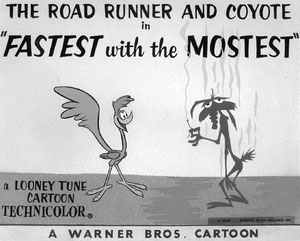 Fastest with the Mostest (Warner, Road Runner, 1/9/60 – Chuck Jones, dir.) – Another typical Road Runner endeavor, with one of the last memorable sign gags of the theatrical series. A simple trick seems to result in the coyote’s lifelong dream. A fake Detour sign causes the Road Runner to run out to the end of a narrow cliff point, with no way back except to face the coyote. Wile E. advances, tying on a bib and producing a knife and fork, while the Road Runner calmly stands there. The coyote takes another step – and a section of the cliff falls out from under him. However, the Road Runner’s portion of the ledge, disconnected from anything, remains stationary in the air with the bird standing on top! Wile E. endures a harrowing series of events. He hits the canyon floor ahead of his utensils, has his knife slash away a stripe of fur from his back, then is speared in the tail by his fork. He leaps into the air in pain, and briefly hangs by the neck from his bib, which catches upon the limb of an old dead tree. The tree topples over, bashing the coyote repeatedly on the head and hammering him through the canyon floor. Wile E. comes out the bottom, falling into the rushing waters of an underground river, which emerges into daylight in a drop from a waterfall, The coyote swims against the current, but is swept over the falls, and straight into a collector pipe at the base of the falls. In action unseen but suggested by sound effects, Wile E. travels through miles of pipelines, being diverted by valves into pipes of smaller and smaller diameter, until he finally comes to a stop at an exterior faucet head. Wile E.’s hand somehow emerges from the faucet, manages to open the tap by turning a handle, and Wile E. is ejected from the pipe like a soggy drip, finding himself back upon the canyon floor where he started. Wile E. looks up, to see the Road Runner still standing upon his small unsupported slab of cliff rock, high above the action. Wile E. can’t resist a comment to the audience, and holds up a sign: “I wouldn’t mind – except he defies the law of gravity!” The Road Runner above responds with a second sign, repeating a punch line from Bugs Bunny’s “High Diving Hare”. The sign reads, “Sure – but I never studied law.” With a final burst of speed, the Road Runner zips away to the opposite canyon ledge, for the iris out.
Fastest with the Mostest (Warner, Road Runner, 1/9/60 – Chuck Jones, dir.) – Another typical Road Runner endeavor, with one of the last memorable sign gags of the theatrical series. A simple trick seems to result in the coyote’s lifelong dream. A fake Detour sign causes the Road Runner to run out to the end of a narrow cliff point, with no way back except to face the coyote. Wile E. advances, tying on a bib and producing a knife and fork, while the Road Runner calmly stands there. The coyote takes another step – and a section of the cliff falls out from under him. However, the Road Runner’s portion of the ledge, disconnected from anything, remains stationary in the air with the bird standing on top! Wile E. endures a harrowing series of events. He hits the canyon floor ahead of his utensils, has his knife slash away a stripe of fur from his back, then is speared in the tail by his fork. He leaps into the air in pain, and briefly hangs by the neck from his bib, which catches upon the limb of an old dead tree. The tree topples over, bashing the coyote repeatedly on the head and hammering him through the canyon floor. Wile E. comes out the bottom, falling into the rushing waters of an underground river, which emerges into daylight in a drop from a waterfall, The coyote swims against the current, but is swept over the falls, and straight into a collector pipe at the base of the falls. In action unseen but suggested by sound effects, Wile E. travels through miles of pipelines, being diverted by valves into pipes of smaller and smaller diameter, until he finally comes to a stop at an exterior faucet head. Wile E.’s hand somehow emerges from the faucet, manages to open the tap by turning a handle, and Wile E. is ejected from the pipe like a soggy drip, finding himself back upon the canyon floor where he started. Wile E. looks up, to see the Road Runner still standing upon his small unsupported slab of cliff rock, high above the action. Wile E. can’t resist a comment to the audience, and holds up a sign: “I wouldn’t mind – except he defies the law of gravity!” The Road Runner above responds with a second sign, repeating a punch line from Bugs Bunny’s “High Diving Hare”. The sign reads, “Sure – but I never studied law.” With a final burst of speed, the Road Runner zips away to the opposite canyon ledge, for the iris out.
• See The Fastest With The Mostest online by CLICKING HERE.
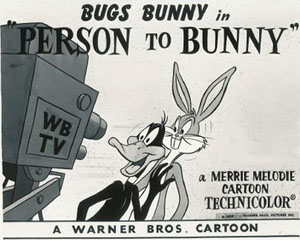 Person to Bunny (Warner, Bugs Bunny, 4/2/60 – Friz Freleng, dir.) – The last of Bugs’s backstage-life-of-a-toon epics from the golden era. The film presents a considerable mystery, also being the last voice appearance of Arthur Q. Bryan as Elmer Fudd. What is odd is that Bryan had died a few years earlier, and the studio had already taken to producing Elmer cartoons substituting Hal Smith in the role. Then how did this last Bryan appearance come to be? The track for Elmer’s lines must have been recorded considerably ahead of the cartoon’s release – but, despite heavy backlogging of completed films, it was not customary for a title to be held back from release so long as the time between Bryan’s death and this film’s premiere. The film’s story structure may be the only clue that Bryan’s tracks may have come from an uncompleted project, perhaps originally envisioned as only starring Bugs and Elmer. The dialog proceeds just so far – and then Elmer’s part in the film abruptly ends, without even giving him a curtain line. Bryan thus might never have completed the recording for the original story treatment, and the project was for a time put on the shelf. In the final version, Daffy Duck is added as an additional star, covering for the absence of a solid ending for Elmer’s part of the picture, and thus seemingly giving renewed life to Bryan’s last recordings, allowing their use through a clever rewrite.
Person to Bunny (Warner, Bugs Bunny, 4/2/60 – Friz Freleng, dir.) – The last of Bugs’s backstage-life-of-a-toon epics from the golden era. The film presents a considerable mystery, also being the last voice appearance of Arthur Q. Bryan as Elmer Fudd. What is odd is that Bryan had died a few years earlier, and the studio had already taken to producing Elmer cartoons substituting Hal Smith in the role. Then how did this last Bryan appearance come to be? The track for Elmer’s lines must have been recorded considerably ahead of the cartoon’s release – but, despite heavy backlogging of completed films, it was not customary for a title to be held back from release so long as the time between Bryan’s death and this film’s premiere. The film’s story structure may be the only clue that Bryan’s tracks may have come from an uncompleted project, perhaps originally envisioned as only starring Bugs and Elmer. The dialog proceeds just so far – and then Elmer’s part in the film abruptly ends, without even giving him a curtain line. Bryan thus might never have completed the recording for the original story treatment, and the project was for a time put on the shelf. In the final version, Daffy Duck is added as an additional star, covering for the absence of a solid ending for Elmer’s part of the picture, and thus seemingly giving renewed life to Bryan’s last recordings, allowing their use through a clever rewrite.
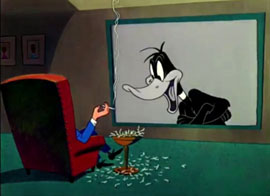 In a lampoon of the popular interview show, “Person to Person” with Edward R, Murrow, Bugs is interviewed by a commentator named “Burrows” for television, with the chain-smoking interviewer speaking from an easy chair in the TV studio, and cameras placed within Bugs’ fashionable rabbit hole in the Hollywood hills. Bugs plays it cool and modest, referring to his dwelling as “not much of a hutch”, and attributing his great success to luck from his rabbit’s feet. Things begin to get out of hand when Daffy Duck comes visiting, and spots the cables and cameras in Bugs’s living room. He catches on that Bugs is being interviewed, and darts in front of the camera, speaking directly to Burrows, and doing everything possible to get interviewed. Bugs pushes Daffy out the door, telling him they’re busy. Daffy lingers outside, however, as the interviewer asks how Bugs always manages to outwit that clever hunter. Elmer Fudd. “Clever? Don’t make me laugh”, responds Bugs, describing Elmer’s I.Q. as P.U. At his own home, Elmer himself is watching the telecast, and literally blows his top at the public insult. He shows up in hunting clothes at Bugs’s hole, and with rifle at the ready, demands that Bugs issue a public apology. Bugs merely plugs up the barrel of Elmer’s rifle when he fires, letting Elmer take the blast, then returns to his rabbit hole to resume the program. He finds Daffy has darted in again the minute Bugs’s back was turned, and is performing an impression of Ted Lewis for the camera. Elmer’s rifle barrel pokes through the front door, and Bugs fakes Daffy out by telling the duck to pose in front of “the close-up lens”. Daffy does, and takes the shotgun blast. With beak bent, Daffy challenges Bugs, declaring that anyone can be a rabbit. He rturns in a rabbit costume, and of course gets spotted by Elmer again, receiving another pot-shot. Daffy finally points Elmer to the real rabbit, and Bugs is pursued by Elmer, the two of them escaping out the rabbit hole, leaving Daffy in command of the cameras. Elmer is quickly dispatched by Bigs, with a reuse of Bugs’s ‘spin the log at a cliff’s edge” routine dating back to “All This and Rabbit Stew” and “The Big Snooze”. This time, there is no falling payoff, as Elmer remains inside the log, silently trapped and afraid to exit out of either end. (The giveaway that Elmer’s true finish was never completed in voicing by Bryan). Bugs concludes that that will leave Elmer guessing for the rest of the day, and returns again to his hole. Daffy is now performing his tap dance routine from “Show Biz Bugs”, and Bugs and the moderator conclude that the only way they’re going to rid themselves of this pest is to put him on. Daffy asks Bigs if all his friends will see him, and Bugs responds, “Yes, and forty million other people.” “Forty million – -“, utters Daffy, as he keels over in a faint. Bugs ends the interview with “Good Night, Mr. Burrows”, as he fans the unconscious Daffy.
In a lampoon of the popular interview show, “Person to Person” with Edward R, Murrow, Bugs is interviewed by a commentator named “Burrows” for television, with the chain-smoking interviewer speaking from an easy chair in the TV studio, and cameras placed within Bugs’ fashionable rabbit hole in the Hollywood hills. Bugs plays it cool and modest, referring to his dwelling as “not much of a hutch”, and attributing his great success to luck from his rabbit’s feet. Things begin to get out of hand when Daffy Duck comes visiting, and spots the cables and cameras in Bugs’s living room. He catches on that Bugs is being interviewed, and darts in front of the camera, speaking directly to Burrows, and doing everything possible to get interviewed. Bugs pushes Daffy out the door, telling him they’re busy. Daffy lingers outside, however, as the interviewer asks how Bugs always manages to outwit that clever hunter. Elmer Fudd. “Clever? Don’t make me laugh”, responds Bugs, describing Elmer’s I.Q. as P.U. At his own home, Elmer himself is watching the telecast, and literally blows his top at the public insult. He shows up in hunting clothes at Bugs’s hole, and with rifle at the ready, demands that Bugs issue a public apology. Bugs merely plugs up the barrel of Elmer’s rifle when he fires, letting Elmer take the blast, then returns to his rabbit hole to resume the program. He finds Daffy has darted in again the minute Bugs’s back was turned, and is performing an impression of Ted Lewis for the camera. Elmer’s rifle barrel pokes through the front door, and Bugs fakes Daffy out by telling the duck to pose in front of “the close-up lens”. Daffy does, and takes the shotgun blast. With beak bent, Daffy challenges Bugs, declaring that anyone can be a rabbit. He rturns in a rabbit costume, and of course gets spotted by Elmer again, receiving another pot-shot. Daffy finally points Elmer to the real rabbit, and Bugs is pursued by Elmer, the two of them escaping out the rabbit hole, leaving Daffy in command of the cameras. Elmer is quickly dispatched by Bigs, with a reuse of Bugs’s ‘spin the log at a cliff’s edge” routine dating back to “All This and Rabbit Stew” and “The Big Snooze”. This time, there is no falling payoff, as Elmer remains inside the log, silently trapped and afraid to exit out of either end. (The giveaway that Elmer’s true finish was never completed in voicing by Bryan). Bugs concludes that that will leave Elmer guessing for the rest of the day, and returns again to his hole. Daffy is now performing his tap dance routine from “Show Biz Bugs”, and Bugs and the moderator conclude that the only way they’re going to rid themselves of this pest is to put him on. Daffy asks Bigs if all his friends will see him, and Bugs responds, “Yes, and forty million other people.” “Forty million – -“, utters Daffy, as he keels over in a faint. Bugs ends the interview with “Good Night, Mr. Burrows”, as he fans the unconscious Daffy.
• Watch PERSON TO BUNNY by CLICKING HERE.
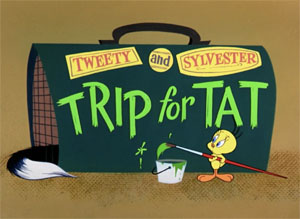 Trip For Tat (Warner, Tweety and Sylvester, 10/29/60 – Friz Freleng, dir.) is a cheater, but with a minimal degree of extra effort behind it. Though it uses several familiar sequences from prior films, unusually, none of the old material is presented precisely as it appeared in earlier pictures. Backgrounds are replaced, and drawings from old scenes are apparently re-traced and photographed in different order to accompany new lines of dialogue, such that it is not merely a clip-fest from the film library. Unusual luxury, for a film skimping on budget to fill quota.
Trip For Tat (Warner, Tweety and Sylvester, 10/29/60 – Friz Freleng, dir.) is a cheater, but with a minimal degree of extra effort behind it. Though it uses several familiar sequences from prior films, unusually, none of the old material is presented precisely as it appeared in earlier pictures. Backgrounds are replaced, and drawings from old scenes are apparently re-traced and photographed in different order to accompany new lines of dialogue, such that it is not merely a clip-fest from the film library. Unusual luxury, for a film skimping on budget to fill quota.
Premise for the film is Granny booking a round-the-world tour at a travel agency for herself and Tweety, with Sylvester naturally tagging along in quest of his canary appetizer. This sets up various clips based upon prior travel films in which the trio appeared, including “Tweety’s S.O.S.”, “A Pizza-Tweety Pie”, and “Tree-Cornered Tweety” (without Granny), However, there are some new sequences added for certain ports of call. A venture to Paris finds both Granny and Tweety studying art at respective easels. Granny attempt finger-painting – meaning a full oil painting of her own finger. Tweety chooses to paint from memory a poorly-proportioned replication of that “bad ol’ putty tat”. Sylvester himself creeps up behind Tweety’s canvas, cutting a hole in it to insert his own head where Tweety’s painted image had been. Tweety looks up to see Sylvester’s scowling “puss”, and reacts with disgust, “Eww, what a ugly face I dwew. I better ewase it.” Producing a pencil eraser, Tweety rubs as Sylvester’s features, until his face is a white blank. Sylvester retains an amazing sense of direction for a character now without eyes, and stumbles his way to a nearby tattoo parlor. He is next seen sitting in a chair in the tattoo studio, as the artist within sketches in the features of his mouth and lips. “For fifty Francs more, I can put a picture of a can of sardines on your chest.” Sylvester, still lacking eyes or nose, remarks grumpily, “Never mind the sardines, Buster. Just finish my face.”
• Watch TRIP FOR TAT by CLICKING THIS.
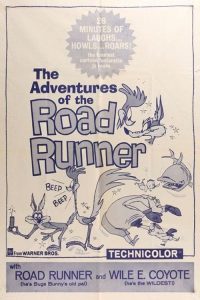 Adventures of the Road-Runner (Warner, Road Runner (Unaired TV pilot, issued theatrically), 6/2/62 – Chuck Jones, dir.) is a heavily augmented cheater, intended to use as a framing vehicle for recycling old clips and re-running old cartoons. Its amount of new animation (though several new scenes are quite static in nature to save on expense) might have been viewed as too costly to perform on a weekly basis, and thus the project never got past the pilot Furthermore, the basic idea may have proven distracting to the original Road Runner footage, depending in primary part upon Wile E. lapsing into his talking mode (traditionally reserved for use only in Bugs Bunny cartoons) to provide observations and commentary. The original films are definitely left better off remaining in pantomime. Moreover, how would they have gotten past the sign gags we’ve been spotlighting in these columns during each week’s show?
Adventures of the Road-Runner (Warner, Road Runner (Unaired TV pilot, issued theatrically), 6/2/62 – Chuck Jones, dir.) is a heavily augmented cheater, intended to use as a framing vehicle for recycling old clips and re-running old cartoons. Its amount of new animation (though several new scenes are quite static in nature to save on expense) might have been viewed as too costly to perform on a weekly basis, and thus the project never got past the pilot Furthermore, the basic idea may have proven distracting to the original Road Runner footage, depending in primary part upon Wile E. lapsing into his talking mode (traditionally reserved for use only in Bugs Bunny cartoons) to provide observations and commentary. The original films are definitely left better off remaining in pantomime. Moreover, how would they have gotten past the sign gags we’ve been spotlighting in these columns during each week’s show?
The first segment of the show includes Wile E. pausing the action of a mishap, to reveal to the viewing audience that it is on film, which he has taken from various hidden cameras in the desert to document his mistakes and improve upon them in later attempts. He revises a lasso placed in the road, to prevent himself from falling backwards into a canyon when he pulls on the rope – but in second attempt lassos a truck instead. He tries once more, bracing the rope with a solid boulder to avoid the truck problem again – only to have the boulder pulled away by the truck, flattening the coyote in the middle like a steamroller.
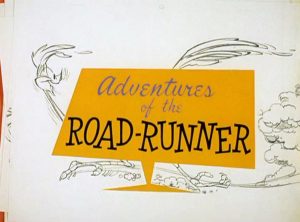 Segment 2 finds two children watching the program on TV. One child dares to ask the question why the coyote bothers to chase the Road Runner anyway. Wile E. pauses on the screen in mid-chase, turning to the child. “A legitimate question, deserving a legitimate answer.” He unveils a set of charts, revealing that, despite its scrawny, stringy appearance, every part of the Road Runner presents to the palate of a coyote a veritable smorgasbord of flavors. A recipe book also discloses a wide variety of ways of preparing and serving a Road Runner, including good old fashioned Road Runner Surprise. Surprise – as the Road Runner creeps up behind the coyote, smacking his own lips (er, beak) at the recipes, and lets out with a “Beep Beep”, shocking the coyote into a headfirst jump through a rock ledge above.
Segment 2 finds two children watching the program on TV. One child dares to ask the question why the coyote bothers to chase the Road Runner anyway. Wile E. pauses on the screen in mid-chase, turning to the child. “A legitimate question, deserving a legitimate answer.” He unveils a set of charts, revealing that, despite its scrawny, stringy appearance, every part of the Road Runner presents to the palate of a coyote a veritable smorgasbord of flavors. A recipe book also discloses a wide variety of ways of preparing and serving a Road Runner, including good old fashioned Road Runner Surprise. Surprise – as the Road Runner creeps up behind the coyote, smacking his own lips (er, beak) at the recipes, and lets out with a “Beep Beep”, shocking the coyote into a headfirst jump through a rock ledge above.
The final segment has Wile E. again resorting to his projector footage, displaying another mishap, and deciding instead to turn to the good old reliable standby of something devised by the ancients – the catapult, displayed on a large blueprint. ‘So simple even a child prodigy can operate it.” Of course, Wile E. finds about seven different ways to get inadvertently flattened by the weapon’s massive boulder. He finally returns to his lair, bandaged and walking with a cane. “So simple a child can operate it – BAH!” He whacks the blueprint with his walking stick – and the catapult arm in the drawing is triggered, dumping the blueprint boulder upon him again. The camera closes in on a corner of the blueprint, identifying it as a product of the Road-Runner Blueprint Company. The final scene has coyote bedding down for the night, only to have the Road Runner zoom through his bedroom, sucking away his bed in the backdraft, and carrying the bed away by racing into the projected image of a desert road still upon the coyote’s projection screen, for the fade out.
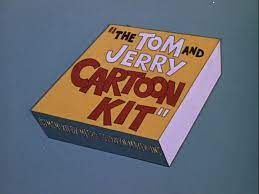 The Tom and Jerry Cartoon Kit (MGM, Tom and Jerry, 8/62 – Gene Deitch, dir.) – Allan Swift provides narration, displaying a boxed package containing all the elements needed for anyone to enter the lucrative field of animated cartoons. “Everything needed for quiet, sophisticated humor.” In compartments of the package are included one mean, stupid cat, one sweet, lovable mouse, assorted deadly weapons, and a pack of Puff cigarettes and a steaming cup of coffee for the animators. Plus, a slice of watermelon, to place the mouse into a simple situation expressing a natural human need – eating. “The results may not make sense, but it will last long enough for you to be comfortably seated before the feature begins.” Jerry begins spitting watermelon seeds, hitting Tom. Tom surprises Jerry, and causes him to swallow a mouthful of seeds. Jerry begins dancing with the seeds juggling in his rear end like the sound of maracas. Tom grabs him up in a kitchen cannister and resumes the dance, tossing Jerry around inside. Suddenly, the rhythmic rustling stops, and Tom looks inside the cannister – only to receive another spit of watermelon seeds right in the face. Tom rushes to the remainder of the slice of watermelon, gobbling it down. Then, his mouth forms into the shape of a cannon, and he begins emitting blasts of concentrated seeds at Jerry. Jerry takes refuge in the kit box, and spots hidden within the assorted deadly weapons a book on judo. By the time Tom arrives on the scene, Jerry has perused the book’s pages, and emerges from the book dressed in kimono, wearing a black belt. Tom is quickly thrown for a loop.
The Tom and Jerry Cartoon Kit (MGM, Tom and Jerry, 8/62 – Gene Deitch, dir.) – Allan Swift provides narration, displaying a boxed package containing all the elements needed for anyone to enter the lucrative field of animated cartoons. “Everything needed for quiet, sophisticated humor.” In compartments of the package are included one mean, stupid cat, one sweet, lovable mouse, assorted deadly weapons, and a pack of Puff cigarettes and a steaming cup of coffee for the animators. Plus, a slice of watermelon, to place the mouse into a simple situation expressing a natural human need – eating. “The results may not make sense, but it will last long enough for you to be comfortably seated before the feature begins.” Jerry begins spitting watermelon seeds, hitting Tom. Tom surprises Jerry, and causes him to swallow a mouthful of seeds. Jerry begins dancing with the seeds juggling in his rear end like the sound of maracas. Tom grabs him up in a kitchen cannister and resumes the dance, tossing Jerry around inside. Suddenly, the rhythmic rustling stops, and Tom looks inside the cannister – only to receive another spit of watermelon seeds right in the face. Tom rushes to the remainder of the slice of watermelon, gobbling it down. Then, his mouth forms into the shape of a cannon, and he begins emitting blasts of concentrated seeds at Jerry. Jerry takes refuge in the kit box, and spots hidden within the assorted deadly weapons a book on judo. By the time Tom arrives on the scene, Jerry has perused the book’s pages, and emerges from the book dressed in kimono, wearing a black belt. Tom is quickly thrown for a loop.
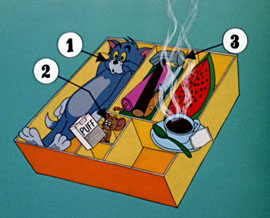 This highly improvisational film creatively uses empty backgrounds of varying color, and meager stylized buildings or props as setting for the story, with the character animation in the foreground taking center stage. Tom’s brows knit in thought as to how to outwit Jerry, merging together to knit a black sweater. A dissolve places Tom in the sweater, entering a gymnasium for boxing training. He goes through all the steps to become a champion fighter, including bag punching, jump rope, and road work, then approaches Jerry in the judo book. Tom demonstrates his one-two punch and fancy footwork, but by the time he lays a glove on Jerry’s finger, Jerry flips him again into a twisted heap. Well, fight fire with fire. Tom enrolls in a judo school, shakes the whole building up with his energetic efforts, and emerges with his own kimono, black belt, and diploma. Jerry is somewhat taken aback at meeting another judo master., and the two exchange bows. Jerry decides to show off his knowledge of karate, setting up a board across two bricks, and chopping it in two. Tom raises the bricks higher by turning them on end, places a log across them, and repeats the chopping trick. Jerry raises the stakes, performing a feat that even impresses Tom, by chopping a large concrete block in two. Tom tries for the topper of toppers, having a crane haul in a huge block of solid granite. As Tom raises his hand to attempt to chop at the block, Jerry notices the bricks beginning to crumble under the weight of the stone. Tom never gets to complete the chop, as the bricks collapse, sending Tom, bricks, and the stone plummeting through a gaping hole in the floor, with a loud crash. The cartoon ends as Tom crawls out of the hole, and falls exhausted back into the cartoon kit box, with Jerry placing the cover back on the box and bowing to the audience, while narrator Swift announces that the next instructional film will be something for the kiddies – on how to make a new poison gas.
This highly improvisational film creatively uses empty backgrounds of varying color, and meager stylized buildings or props as setting for the story, with the character animation in the foreground taking center stage. Tom’s brows knit in thought as to how to outwit Jerry, merging together to knit a black sweater. A dissolve places Tom in the sweater, entering a gymnasium for boxing training. He goes through all the steps to become a champion fighter, including bag punching, jump rope, and road work, then approaches Jerry in the judo book. Tom demonstrates his one-two punch and fancy footwork, but by the time he lays a glove on Jerry’s finger, Jerry flips him again into a twisted heap. Well, fight fire with fire. Tom enrolls in a judo school, shakes the whole building up with his energetic efforts, and emerges with his own kimono, black belt, and diploma. Jerry is somewhat taken aback at meeting another judo master., and the two exchange bows. Jerry decides to show off his knowledge of karate, setting up a board across two bricks, and chopping it in two. Tom raises the bricks higher by turning them on end, places a log across them, and repeats the chopping trick. Jerry raises the stakes, performing a feat that even impresses Tom, by chopping a large concrete block in two. Tom tries for the topper of toppers, having a crane haul in a huge block of solid granite. As Tom raises his hand to attempt to chop at the block, Jerry notices the bricks beginning to crumble under the weight of the stone. Tom never gets to complete the chop, as the bricks collapse, sending Tom, bricks, and the stone plummeting through a gaping hole in the floor, with a loud crash. The cartoon ends as Tom crawls out of the hole, and falls exhausted back into the cartoon kit box, with Jerry placing the cover back on the box and bowing to the audience, while narrator Swift announces that the next instructional film will be something for the kiddies – on how to make a new poison gas.
• Watch THE TOM & JERRY CARTOON KIT by clicking HERE.
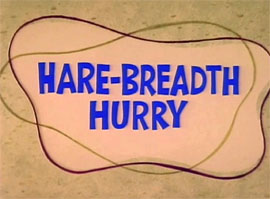 Hare-Breadth Hurry (Warner, Bugs Bunny, 6/63 – Chuck Jones, dir.) – Bugs and Wile E. Coyote had by this time had four prior meetings, all featuring the erudite speaking version of Wile E. seen in the bridging sequences of “The Adventures of the Roadrunner”, to allow for clever verbal interplay between the characters. For reasons unknown, this final theatrical meeting of the pair features Wile E. in standard silent pantomime mode, with Bugs doing all the talking, mostly to the audience. Also, it begins on the unlikeliest of premises. We see from long-distance angles what appears to be a standard coyote-Road Runner chase in progress, but not from close enough range to see who’s in the blur in front. Suddenly, as the chase rounds a turn, the forward blur in the lead stops, revealing it’s Bugs Bunny, who addresses the audience. “Hi. I suppose you’re expecting the Road Runner. Well, he sprained a giblet rounding a sharp curve the other day, so I’m standing in for him.” A strange idea, unlike all previous instances of Bugs being hunted in his natural habitat. Was Chuck cheating and quickly trying to fill Bugs’s quota with what really was a standard Road Runner script? Or did this story actually originate as a departure in pair-ups for Bugs and Wile E.? We may never know, but the lack of coyote dialogue, and the somewhat grafted-on feel of Bugs’s lines, makes me suspect that producing a cheater was more likely than original intent for a pair-up.
Hare-Breadth Hurry (Warner, Bugs Bunny, 6/63 – Chuck Jones, dir.) – Bugs and Wile E. Coyote had by this time had four prior meetings, all featuring the erudite speaking version of Wile E. seen in the bridging sequences of “The Adventures of the Roadrunner”, to allow for clever verbal interplay between the characters. For reasons unknown, this final theatrical meeting of the pair features Wile E. in standard silent pantomime mode, with Bugs doing all the talking, mostly to the audience. Also, it begins on the unlikeliest of premises. We see from long-distance angles what appears to be a standard coyote-Road Runner chase in progress, but not from close enough range to see who’s in the blur in front. Suddenly, as the chase rounds a turn, the forward blur in the lead stops, revealing it’s Bugs Bunny, who addresses the audience. “Hi. I suppose you’re expecting the Road Runner. Well, he sprained a giblet rounding a sharp curve the other day, so I’m standing in for him.” A strange idea, unlike all previous instances of Bugs being hunted in his natural habitat. Was Chuck cheating and quickly trying to fill Bugs’s quota with what really was a standard Road Runner script? Or did this story actually originate as a departure in pair-ups for Bugs and Wile E.? We may never know, but the lack of coyote dialogue, and the somewhat grafted-on feel of Bugs’s lines, makes me suspect that producing a cheater was more likely than original intent for a pair-up.
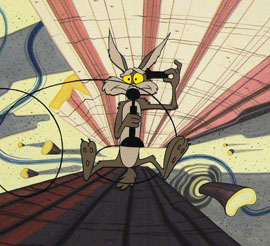 There are other strange aspects to this film. If imitating a Road Runner cartoon, it is the only one in which the characters do not pause for their mock-Latin species names to be revealed. There is further a plot inconsistency. Bugs points out to us that this is the point where the Road Runner turns on that extra little burst of speed, and quickly pops something in his mouth. After several shots of reused animation from previous films showing him ripping out pavement, tunnels, etc. in his wake, Bugs tells us he really can’t run this fast, but is imitating the Road Runner with the help of a bottle of Acme Super Speed Vitamins. Bad idea to trust anything from the Acme catalog. With the sounds of sputtering engines and screech of brakes, the pills abruptly wear off, leaving Bugs a drooping mass in the road. “Ran outta gas, or vitamins, or sumpthin’” (An awkward line as delivered by Mel, which would have been funnier if he just left it as “Ran outta gas.”) Yet, in a later sequence discussed below, Bugs is seen running again. Do Acme Vitamins possess the trait of coming back to full potency again at unexpected intervals?
There are other strange aspects to this film. If imitating a Road Runner cartoon, it is the only one in which the characters do not pause for their mock-Latin species names to be revealed. There is further a plot inconsistency. Bugs points out to us that this is the point where the Road Runner turns on that extra little burst of speed, and quickly pops something in his mouth. After several shots of reused animation from previous films showing him ripping out pavement, tunnels, etc. in his wake, Bugs tells us he really can’t run this fast, but is imitating the Road Runner with the help of a bottle of Acme Super Speed Vitamins. Bad idea to trust anything from the Acme catalog. With the sounds of sputtering engines and screech of brakes, the pills abruptly wear off, leaving Bugs a drooping mass in the road. “Ran outta gas, or vitamins, or sumpthin’” (An awkward line as delivered by Mel, which would have been funnier if he just left it as “Ran outta gas.”) Yet, in a later sequence discussed below, Bugs is seen running again. Do Acme Vitamins possess the trait of coming back to full potency again at unexpected intervals?
 Most of the film plays like a standard Road Runner episode, with Wile E.’s schemes mainly causing his own downfall, and Bugs only occasionally having opportunity to use hus iwn wits to get out of trouble. Bugs from time to time provides commentary, such as “It’s amazing the trouble this joker goes to to get a square meal. Case in point.” Bugs only retaliates three times. First, he draws a line across the pavement for Wile E. to cross, then draws a second one. When Wile E. crosses the first line, the two lines prove to be the outlines of a supportless platform in the road, upon which Wile E. plunges into a deep hole and a watery splash of some kind below. In a second sequence (the one where Bugs is running again), Bugs declares that it’s only sporting to give the coyote a running shot at him once in a while. Wile E. waits with rifle aimed along the side of the road, and squeezes the trigger as Bugs approaches. But a plugging sound is heard just before the trigger is pulled, and Wile E. hears no shot. He checks out the end of the gun barrel, and finds a pipe fitting connected to it. In another rare instance of a studio copping a gag from a Terrytoon, Wile E. follows the connected pipe, which twists and turns its way around the desert rock faces, in much the same manner as Spoofy the fox’s drawn extension upon the hunter’s gun barrel in “Foxed By a Fox”, leading to the coyote finally discovering the end of the pipe just in time to meet the escaping bullet, which blasts in his face. Finally. Bugs uses an old idea of Wile E.’s – spreading glue on the road. The coyote’s feet stick while his torso tries to extend forward at his usual high speed. The coyote looks for anything to grab onto to keep from snapping backwards, and clutches to the framework of a desert telephone booth. The phone rings, and Bugs pops up to answer it, then addresses the coyote: “It’s for you”. Wile E. lets go of the door frame to take the receiver, and is snapped backwards by the glue. Still clutching the phone line, his torso passes the point where his feet are glued, and he uproots the slab of pavement he is glued to. He crashes backwards into a canyon wall, is flattened by the pavement sab, and the begins falling into the canyon, but is suspended by the phone wire. Bugs speaks to him through the phone line, stating that Wile E. hasn’t paid his phone blll in a while, so they’ll have to cut him off. A snip of the wire with a pair of scissors by Bugs, and Wile E. takes the same old plunge into the canyon. Bugs ends with a moral: “Never get cut off in the middle of a long-distance fall.”
Most of the film plays like a standard Road Runner episode, with Wile E.’s schemes mainly causing his own downfall, and Bugs only occasionally having opportunity to use hus iwn wits to get out of trouble. Bugs from time to time provides commentary, such as “It’s amazing the trouble this joker goes to to get a square meal. Case in point.” Bugs only retaliates three times. First, he draws a line across the pavement for Wile E. to cross, then draws a second one. When Wile E. crosses the first line, the two lines prove to be the outlines of a supportless platform in the road, upon which Wile E. plunges into a deep hole and a watery splash of some kind below. In a second sequence (the one where Bugs is running again), Bugs declares that it’s only sporting to give the coyote a running shot at him once in a while. Wile E. waits with rifle aimed along the side of the road, and squeezes the trigger as Bugs approaches. But a plugging sound is heard just before the trigger is pulled, and Wile E. hears no shot. He checks out the end of the gun barrel, and finds a pipe fitting connected to it. In another rare instance of a studio copping a gag from a Terrytoon, Wile E. follows the connected pipe, which twists and turns its way around the desert rock faces, in much the same manner as Spoofy the fox’s drawn extension upon the hunter’s gun barrel in “Foxed By a Fox”, leading to the coyote finally discovering the end of the pipe just in time to meet the escaping bullet, which blasts in his face. Finally. Bugs uses an old idea of Wile E.’s – spreading glue on the road. The coyote’s feet stick while his torso tries to extend forward at his usual high speed. The coyote looks for anything to grab onto to keep from snapping backwards, and clutches to the framework of a desert telephone booth. The phone rings, and Bugs pops up to answer it, then addresses the coyote: “It’s for you”. Wile E. lets go of the door frame to take the receiver, and is snapped backwards by the glue. Still clutching the phone line, his torso passes the point where his feet are glued, and he uproots the slab of pavement he is glued to. He crashes backwards into a canyon wall, is flattened by the pavement sab, and the begins falling into the canyon, but is suspended by the phone wire. Bugs speaks to him through the phone line, stating that Wile E. hasn’t paid his phone blll in a while, so they’ll have to cut him off. A snip of the wire with a pair of scissors by Bugs, and Wile E. takes the same old plunge into the canyon. Bugs ends with a moral: “Never get cut off in the middle of a long-distance fall.”
• Watch HARE-BREATH HURRY by CLICKING HERE.
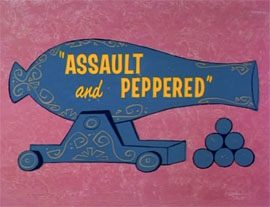 Assault and Peppered (Warner, Daffy and Speedy, 4/14/65. Robert McKimson, dir.) – The pairings of Daffy Duck and Speedy Gonzales in the DePatie/Freleng years following the closing of Termite Terrace always seemed, to say the least, forced. In fact, they were. Freleng’s new studio had had difficulty translating Sylvester to more limited animation, his design in his few late appearances such as “Road to Andalay” seeming a primitive shadow of his former self. Daffy for some reason seemed easier to adapt, and Speedy Gonzales was more-or-less child’s play to Freleng’s pencil. So, the two easiest of the classic characters became an unlikely pair out of economic necessity, despite there being no natural animosity in the wild between a mouse and a duck. Whatever possible noble intents the artists may have had in trying to artificially manufacture a comedy team, results in my humble opinion were generally downright poor. However, where there are rules, there are sometimes exceptions, and this was practically the only entry out of the series I confess to enjoying.
Assault and Peppered (Warner, Daffy and Speedy, 4/14/65. Robert McKimson, dir.) – The pairings of Daffy Duck and Speedy Gonzales in the DePatie/Freleng years following the closing of Termite Terrace always seemed, to say the least, forced. In fact, they were. Freleng’s new studio had had difficulty translating Sylvester to more limited animation, his design in his few late appearances such as “Road to Andalay” seeming a primitive shadow of his former self. Daffy for some reason seemed easier to adapt, and Speedy Gonzales was more-or-less child’s play to Freleng’s pencil. So, the two easiest of the classic characters became an unlikely pair out of economic necessity, despite there being no natural animosity in the wild between a mouse and a duck. Whatever possible noble intents the artists may have had in trying to artificially manufacture a comedy team, results in my humble opinion were generally downright poor. However, where there are rules, there are sometimes exceptions, and this was practically the only entry out of the series I confess to enjoying.
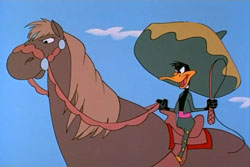 Daffy is cast as wealthy ranchero, Don Daffy De La Scrooge De (indecipherable Spanish) De La Quack, Jr. (What a move-up on the world from his usual poverty.) His rancho spreads far and wide with foodstuffs, but the adjoining territory of the mice is a barren desert. Daffy doesn’t take kindly to peon mice hanging around his land and starving – it lowers the property value. One of the mice remarks that things would be different if his cousin Speedy Gonzalez was here. Daffy snaps a whip that shatters the mouse’s sombrero, ordering him to speak only when spoken to, and declares Speedy Gonzalez a myth. A trail of dust signals Speedy’s appearance behind Daffy and his overweight horse, and a sudden yell of “Yee-hah” sends the horse leaping into the air, coming down on Daffy’s back. The horse gallops away, and Speedy finds aside the crater left by the horse’s weight Daffy’s loose bill. “Here is your big mouth, Senor Ducks”, says Speedy, handing the bill back to the mouthless Daffy. Daffy demands satisfaction for being made to “lose face” in front of the mice, and challenges Speedy to a duel. Speedy is new to this game, and Daffy demands nothing so menial as mere pistols – dueling in “the grand manor”. In other words, total war, between two rival forts.
Daffy is cast as wealthy ranchero, Don Daffy De La Scrooge De (indecipherable Spanish) De La Quack, Jr. (What a move-up on the world from his usual poverty.) His rancho spreads far and wide with foodstuffs, but the adjoining territory of the mice is a barren desert. Daffy doesn’t take kindly to peon mice hanging around his land and starving – it lowers the property value. One of the mice remarks that things would be different if his cousin Speedy Gonzalez was here. Daffy snaps a whip that shatters the mouse’s sombrero, ordering him to speak only when spoken to, and declares Speedy Gonzalez a myth. A trail of dust signals Speedy’s appearance behind Daffy and his overweight horse, and a sudden yell of “Yee-hah” sends the horse leaping into the air, coming down on Daffy’s back. The horse gallops away, and Speedy finds aside the crater left by the horse’s weight Daffy’s loose bill. “Here is your big mouth, Senor Ducks”, says Speedy, handing the bill back to the mouthless Daffy. Daffy demands satisfaction for being made to “lose face” in front of the mice, and challenges Speedy to a duel. Speedy is new to this game, and Daffy demands nothing so menial as mere pistols – dueling in “the grand manor”. In other words, total war, between two rival forts.
The set-up is something akin to Freleng’s battle of Bagel Heights in “Bunker Hill Bunny”. Daffy and Speedy each single-handedly man opposing forts, armed with cannon. Within his command center, Speedy attempts to plot out strategies for the impending war. Daffy decides to peek over his shoulder, with an extending telescope that stretches all the way into Speedy’s window across the battlefield. Speedy spots Daffy’s eye in the telescope lens, and accuses him of cheating. He gives the lens-eye a poke, and somehow, Daffy gets it in his real eye on the other end. “I’m gonna get you for that. That’s just going to double the agony.” Daffy fires a first cannon shot. Speedy turns on his speed, opening door after door to allow the soaring cannonball to zoom around without hitting anything – and even taking the time to move a TV set out of the way to escape harm. Somehow, after guiding the flying metal ball through door after door, corridor after corridor, the cannonball’s flight is U-turned, and it exits through the front gate, headed back to Daffy’s fort. Speedy again outraces it, knocking on Daffy’s front door, to announce that he is returning the cannonball. Daffy takes a direct hit in the chest, while Speedy notes to the audience, “Cannon balls are very expensive. They shouldn’t be wasted.”
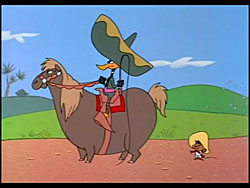 Daffy prepares for another round. Speedy complains from his fort that fighting with cannon is unfair, as Speedy has no cannon balls of his own. Snickering Daffy responds that he has plenty, and will keep sending them over – as he tugs on a rope to activate the firing pin of his weapon again. Unfortunately, he tugs too hard, causing the cannon barrel to flip over backwards – and takes another blast right in the face. A fade out, and then Speedy is seen knocking at Daffy’s door, asking in neighborly fashion to borrow a cannon ball. Daffy serves one up, aiming a cannon right at his face. But before Daffy can fire, Speedy zips inside the barrel, and rolls the cannon ball out, taking it to his own fort, with the promise that he will return it soon. Daffy follows as Speedy enters his fort and slams the door. Daffy pounds upon the door, demanding to be given back his cannonball. Speedy reverses Daffy’s trick, opening the door with muzzle of his own cannon aimed at Daffy. “Okay, Indian giver”, says Speedy, then fires. Daffy is blasted backwards atop the cannonball, and both enter the mouth of Daffy’s cannon across the way. Daffy’s cannon fires, blasting both Daffy and the ball back to Speedy’s doorstep. Speedy opens the door again, spotting the cannonball, and remarks. “Oh, you changed your mind. Gracias.” Speedy thus again takes the cannonball inside, while Daffy weakly moans, “You’re not welcome.”
Daffy prepares for another round. Speedy complains from his fort that fighting with cannon is unfair, as Speedy has no cannon balls of his own. Snickering Daffy responds that he has plenty, and will keep sending them over – as he tugs on a rope to activate the firing pin of his weapon again. Unfortunately, he tugs too hard, causing the cannon barrel to flip over backwards – and takes another blast right in the face. A fade out, and then Speedy is seen knocking at Daffy’s door, asking in neighborly fashion to borrow a cannon ball. Daffy serves one up, aiming a cannon right at his face. But before Daffy can fire, Speedy zips inside the barrel, and rolls the cannon ball out, taking it to his own fort, with the promise that he will return it soon. Daffy follows as Speedy enters his fort and slams the door. Daffy pounds upon the door, demanding to be given back his cannonball. Speedy reverses Daffy’s trick, opening the door with muzzle of his own cannon aimed at Daffy. “Okay, Indian giver”, says Speedy, then fires. Daffy is blasted backwards atop the cannonball, and both enter the mouth of Daffy’s cannon across the way. Daffy’s cannon fires, blasting both Daffy and the ball back to Speedy’s doorstep. Speedy opens the door again, spotting the cannonball, and remarks. “Oh, you changed your mind. Gracias.” Speedy thus again takes the cannonball inside, while Daffy weakly moans, “You’re not welcome.”
Daffy booby-traps the battlefield with dozens upon dozens of land mines, carefully drawing X’s upon a chart to keep track of where they are buried. The last one is placed outside of Speedy’s door, and Daffy gloats that only he knows where they are buried. “That makes two of us”, says Speedy, as he reaches out the door of his fort, snatching Daffy’s chart away. Daffy panics, wondering how he will ever get back to his fort without the chart. From the railing of the fort above, Speedy calls down that he promises to tell Daffy where the mines are. Nervous, but believing in Speedy’s promise, Daffy takes a cautious step forward. BOOM! “There’s one”, says Speedy. BLAM! “There’s another.” This goes on again and again for several more explosions, Speedy always chiming in just after the blasts. Then Seedy remarks, “What you mean, you don’t know where they are. You haven’t missed one yet.” “Aw, shut up”, moans Daffy, as he collapses minus most of his feathers in his fort doorway.
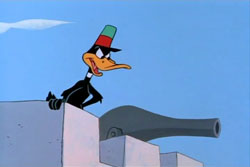 A fade, and then the surprising sight of Speedy waving a white flag. He has tired of playing war games, and wants to go home for a good meal, so surrenders the battle. Daffy is pleasantly amazed, cognizantly remarking regarding his own past screen track record, “I won the war! Usually, I come out of these things getting the worst of it. I think I’ll give myself a 21 gun salute for the victory.’ Soon, Daffy has set up 21 cannons, all with ropes from the firing pins leading back to Daffy’s hand. Daffy tugs to start the salute – but repeats his mistake from earlier in the film, tugging too hard. All the cannons flip over, and one-by-one, take their turns firing at the fleeing Daffy. As Daffy races deep into the landscape, dodging one blast after another, Speedy watches from a distant hill, counting, “…18…19…20…..Only 20?” A final delayed blast soars across the desert. dropping Daffy in his tracks. “That makes 21″, Speedy giggles, for the fade out.
A fade, and then the surprising sight of Speedy waving a white flag. He has tired of playing war games, and wants to go home for a good meal, so surrenders the battle. Daffy is pleasantly amazed, cognizantly remarking regarding his own past screen track record, “I won the war! Usually, I come out of these things getting the worst of it. I think I’ll give myself a 21 gun salute for the victory.’ Soon, Daffy has set up 21 cannons, all with ropes from the firing pins leading back to Daffy’s hand. Daffy tugs to start the salute – but repeats his mistake from earlier in the film, tugging too hard. All the cannons flip over, and one-by-one, take their turns firing at the fleeing Daffy. As Daffy races deep into the landscape, dodging one blast after another, Speedy watches from a distant hill, counting, “…18…19…20…..Only 20?” A final delayed blast soars across the desert. dropping Daffy in his tracks. “That makes 21″, Speedy giggles, for the fade out.
NEXT: Late ‘60’s theatricals.